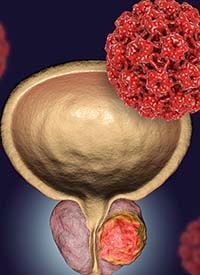Article
PSMA-targeted therapy shows early promise in locally advanced prostate cancer
Author(s):

Now that pivotal trials have demonstrated a survival benefit with PSMA-targeted therapy in metastatic prostate cancer, researchers are hoping to deliver the exciting new approach earlier in the disease course. Accordingly, findings presented at the 2021 American Urological Association Annual Meeting showed early promise with neoadjuvant 177Lu-PSMA imaging and therapy in patients with locally advanced, high-risk disease.1
Specifically, 177Lu-PSMA imaging and therapy followed by radical prostatectomy exhibited a favorable safety profile and early signs of efficacy. In the prospective, open-label, single-arm trial (NCT04297410), 11 patients treated with lutetium who underwent a radical prostatectomy had a biochemical response. Positive surgical margins were reported in 27% (3/11) of patients. At 3-months after surgery, all patients had achieved continence recovery.
“High-risk localized prostate cancer remains a therapeutic challenge,” said presenting author Michael Frumer, MD, a physician in the department of urology at Rabin Medical center in Petah Tikva, Israel. “The introduction of theranostics [has brought about] new treatment opportunities. Treatment with lutetium-PSMA is based on the ability of PSMA ligand that is labeled with the radioisotope 177-lutetium to bind specifically to PSMA-expressing prostate cancer cells to cause cellular damage. Recently, the efficacy of lutetium PSMA has been demonstrated in castrate-resistant metastatic prostate cancer.”
The study enrolled a total of 12 patients with high-risk, locally advanced prostate cancer, 7 who had Gleason Grade Group (GGG) 4 disease and 5 with GGG 5 disease. Investigators administered two 7.4 GBq lutetium treatments, one at 8 weeks prior to radical prostatectomy followed by pelvic node dissection and one at 6 weeks prior. The goal of the trial was to evaluate for the first time the safety and immediate oncological outcomes of lutetium PSMA followed by radical prostatectomy.
The median age of the population was 66 (range, 60-68). The median baseline PSA was 11.4 ng/dL. Of the 12 patients who received lutetium-PSMA treatment, 11 underwent surgery.
Periprostatic adhesions were encountered during surgery without any intraoperative complications in 2 patients. The median surgical length was 220 minutes (range, 165-250), and the median estimated blood loss was 300 mL (IQR 200, 400). Median PSA levels decreased by 28% during treatment and the median hospital stay was 4 days (range, 3-4).
Regarding safety, the only adverse event (AE) reported during the treatment was fatigue occurring in 2 patients. Investigators did not record any incidence of dry mouth or blood count changes. A single patient experienced fever postoperatively. Treatment-related histological changes were noted in 4 of the 6 final surgical specimens. No blood count changes, or dry mouth were reported during treatment with lutetium-PSMA.
Postoperatively, pneumonia was reported in 1 patient. Another patient experienced a postoperative urine leak with conservative management.
“Neoadjuvant lutetium-PSMA followed by radical prostatectomy appears to be safe in patients with locally advanced high-risk prostate cancer,” concluded Frumer. “While longer oncological outcomes are pending, continence recovery seems to be unaffected by lutetium treatment.”
Reference
1. Frumer M, Rosenbaum E, Kedar D, et al. MP15-20: Neo-adjuvant 177Lu-PSMA-I&T radionuclide in high-risk prostate cancer before radical prostatectomy: a feasibility trial. Poster presented at: the American Urological Association 2021 Annual Meeting, virtual. September 10-13, 2021. Abstract MP15-20.
















